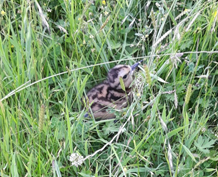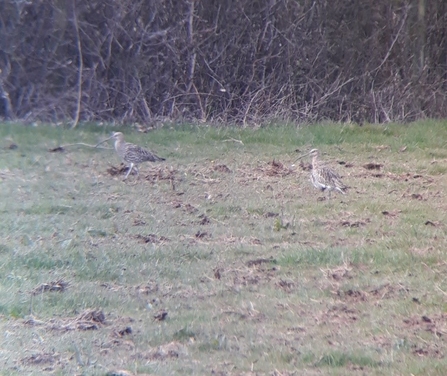Year Summary
It was a disappointing year. The number of fledged young remained low at two, the same as in 2021 and although pairs all returned to their regular nest sites, many never appeared to attempt to nest and/or disappeared very early. Predation was the presumed reason for at least 50% of these failures although was not confirmed definitely at any. The ability to do so was partly due to our failure in nest finding (only two were physically located) which meant that we had little opportunity to set nest cameras. The outbreak of HPAI (aka bird flu) also meant that we were unable to colour ring any more birds but on a brighter note at least two of the birds we ringed last year returned to Herefordshire for the breeding season.
Continuing with slightly better news, we were pleased to finally confirm presence and breeding by Curlews at one of our long term ‘possible’ sites near Llanveynoe. There is promise too at another long term historical Curlew site Letton Lakes, where full access has now been granted. We are hopeful that at least one pair are still breeding there.
We have exciting plans for 2023; financial support has now been obtained from two sources, Herefordshire Wildlife Trust’s Curlew Project fund and the Peter Gardner Legacy fund held by Herefordshire Ornithological Club. We are very grateful to both organisations for their support.
We intend to use this money over the next three years to pay for the colour ringing and GPS tagging of as many of our Herefordshire Curlews as possible. The aim is to better understand the habits and movements of Curlews in the county and discover causes of breeding failure with a view to overcoming them. This will also be a benefit to the wider Curlew support network, of which we are part, as it will inform them and us what our Curlews are doing outside of the breeding season. At the time of writing we are awaiting approval from BTO for GPS tagging but the colour ringing should definitely go ahead, avian flu permitting. Chris Robinson (on behalf of the Herefordshire Curlew Project Steering Group)
Site Reports
NOTE: Over the life of the Project most Herefordshire Curlews have returned to more or less the same place to breed each year. For this reason we have been able to retain the same name for nearly all our sites year-on-year. The few exceptions are due either to the pair moving their territory some distance away or our initial uncertainty about their site preference necessitating a name change as the position became clearer. All site names in this report reflect the 2022 status but any previously used names are included in brackets to maintain continuity. Notes are included in some of the site reports to clarify this naming.
Abbey Farm, Craswall:
A pair was present throughout the season but the birds were elusive and there were few sightings. No evidence of breeding was found. The farmer thought that there might have been an early nest which was predated. Carrion crows are present in large numbers (maximum count 45 on 18th May)
Ball’s Cross:
A pair close to last year’s site was a promising start and defensive attacks on overflying Carrion Crow was seen on 2nd May. On 8th May the pair was seen together suggesting predation had occurred and there were no further sightings after 16th May.
Broadmeadow Farm, Clehonger:
A pair was first seen on 6th April and they were still being seen together on 21st May. A pair together at that time of year suggested that they had either not nested or had been predated but subsequent behaviour and sightings of a single bird indicated that the pair might have relayed. A possible nest area was identified but a nest was not located.
Castleton:
Many early records, with up to 10 birds present in the immediate area. A pair remained around last year’s fields and it was thought that they produced hatched young from a relayed nest after early predation of their first attempt. Alarm calling birds indicated that young were present but none were seen and the pair had disappeared by end of June.
Celtic Vale, Longtown:
This site remains on our list but there was only one report of Curlews being heard by residents. 3 visits to the site drew a blank.
Clehonger Court:
It seems likely that this site is no longer attractive to Curlews. The majority of fields are rotational arable cropping and too disturbed. Birds previously seen here may have moved to the Madley area [see below].
Clifford:
There was a pair of Curlews by the second week of April. They were calling daily and looked to have settled on their previous fields but after a week they mysteriously disappeared not to return.
Eau Withington:
The regular local watcher was not able to do much this year due to illness and visits by others were also limited. We did not find any evidence of breeding. Curlews were present early in the season but (maybe due to the lack of coverage) we had no further sightings until 26th June when a single bird was seen in the area of last year’s nest field.
Hampton Meadow/Dormington:
We are treating this area as one site. The pair which bred on Hampton Meadow in 2019 were presumed to be the same pair that nested the following year and 2021 in fields further east (Dormington). A pair was regularly seen this year feeding on adjacent fields and on previous nest territories but they did not remain until nesting.
In mid-June a bird was heard and seen in flight alarm calling, indicating they may have nested in the area. Despite, much searching Curlew were not heard or seen.
Hergest Ridge:
This site will be dropped from our list. No records were received this year and no searches were made.
Holme Lacy (Fownhope):
Like the Hampton Meadow site this is more of an area than a specific site. There were strong indications of breeding in 2018 but since then the field has not been used and attempts to locate any new nest site have been unsuccessful. This year the area once again held a pair of Curlew but it seems mainly for feeding and loafing. However this pair nested on the other side of the River Wye in Fownhope parish. It was presumed to have been predated when grass was cut for silage in an adjacent field.
Letton Lakes:
This is a historical Curlew site, which has not been intensively monitored for Curlew previously. Access was withdrawn a week or two after the first Covid19 lockdown and was not reinstated until spring this year.
10th April, there was the first sighting of Curlew, two birds were seen calling in flight.
19th April four Curlew, including a bird colour ringed in west Wales were located on floodwater remains. They flew off in direct flight, to the east presumably, heading to their breeding grounds.
The following day there were six birds, three pairs which remained all day. Subsequently, two birds were regularly seen showing nesting behaviour.
19th May was the last sighting. This would appear to a pre nesting gathering area and, a probable nest site. Surprisingly, there was little evidence of avian predators.
Little Mountain:
This is the only site on our list where the landowner does not allow access. Monitoring can only be done at a distance. A pair was present from mid-April and remained until end of June. Breeding was suspected but could not be confirmed.
Llanveynoe:
This area has been on our ‘possibles’ list following sporadic sightings/hearings over the previous two or three of years. Birds were being heard from April on wards and on May 3rd we received a report of a Curlew attacking an overflying Red Kite. A subsequent visit revealed a nest with 4 eggs. The landowner was supportive of our intention to electric fence the nest if and when the field was grazed but there was a break down in our communications and sheep were let into the field before we had done so and, sadly, the eggs were lost.
Lower Lugg Meadows:
Two pairs were seen early season and one pair nested with three eggs. These all hatched and two chicks fledged. Our only known FLEDGING SUCCESS this year.
Birds were first seen on 17th February, rising to a maximum of 15 birds on floodwater.
On 3rd April, after an absence of 26 days, two Curlew returned, including the colour ringed site female.
On 8th May, a nest was located with three eggs, all had hatched by 7th June.
On 5th July, two chicks were observed flying. They were last seen on 27th July.
Madley (Eaton Bishop):
There were very promising gatherings of Curlew from 11th March. There were up to 7 birds present with 2 apparently paired. Sightings continued until 8th April when the fields were ploughed. The pools which were the site of last year’s roost were dry.
On 5th April, a secondary roost was located to the west, in a nearby field of wheat. It held three birds for several evenings, reducing to two birds. The last sighting was 25th April, when two birds flew in from the direction of the nest site.



